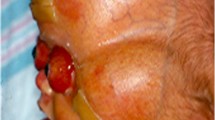Abstract
Mutations in the fibroblast growth factor receptor 2 (FGFR2) gene have been identified in Crouzon syndrome, an autosomal dominant condition causing premature fusion of the cranial sutures (craniosynostosis). A mutation in FGFR1 has been established in several families with Pfeiffer syndrome, where craniosynostosis is associated with specific digital abnormalities. We now report point mutations in FGFR2 in seven sporadic Pfeiffer syndrome patients. Six of the seven Pfeiffer syndrome patients share two missense mutations, which have also been reported in Crouzon syndrome. The Crouzon and Pfeiffer phenotypes usually breed true within families and the finding of identical mutations in unrelated individuals giving different phenotypes is a highly unexpected observation.
Similar content being viewed by others
References
Cohen, M.M. Jr., Craniosynostosis: Diagnosis, Evaluation and Management. (Raven Press, New York, 1996).
Winter, R.M. and Baraitser, M. The London Dysmorphology Database. (Oxford University Press, (1994).
Reardon, W., Winter, R.M., Rutland, P., Pulleyn, L.J., Jones, B.M. & Malcolm, S. Mutations in the fibroblast growth factor 2 gene cause Crouzon syndrome. Nature Genet. 8, 98–103 (1994).
Jabs, E.W. et al. Jackson-Weiss and Crouzon syndromes are allelic with mutations in fibroblast growth factor receptor 2. Nature Genet. 8, 275–279 (1994).
Wilkie, A.O.M. et al. Apert syndrome results from localised mutations of FGFR2 and is allelic with Crouzon syndrome. Nature Genet. 9, XX–YY (1995).
Muencke, M. et al. A common mutation in the fibroblast growth factor receptor 1 gene In Pfeiffer syndrome. Nature Genetics 8, 269–274.
Robin, N.H. et al. Linkage of Pfeiffer syndrome to chromosome 8 centromere and evidence for genetic heterogeneity. Hum. molec. Genet. 3, 2153–2158 (1994).
Kroczek, R.A., Muhlbauer, W. & Zimmermann, I. Cloverleaf skull associated with Pfeiffer syndrome: pathology and management. Eur. J. Pediatr. 145, 442–445 (1986).
Hodacn, R.J. et al. Studies of malformation syndromes In man XXXVI:the Pfeiffer syndrome, association with Kleeblattschadel and multiple visceral anomalies. Z. Kinderheilk. 119, 87–103 (1975).
Soekerman, D., Fryns, J.P. & Van Den Berghe, H. Pfeiffer acrocephalosyndactyly syndrome in mother and son with Cloverleaf skull anomaly in the child. Genet Counsel. 3, 217–220 (1992).
Cohen, M.M. Jr., Pfeiffer syndrome update, clinical subtypes and guidelines for differential diagnosis. Am. J. med. Genet. 45, 300–307 (1993).
Johnson, D.E., Lu, J., Chen, H., Werner, S. & Williams, L.T. The human fibroblast growth factor genes: a common structural arrangement underlies the mechanisms for generating receptor forms that differ in their third immunoglobulin domain. Molec. Cell. Biol. 11, 4627–4634 (1991).
Baraitser, M., Bowen-Bravery, M. & Saldana-Garcia, P. Pitfalls of genetic counselling in Pfeiffer's syndrome. J. med. Genet. 17, 250–256 (1980).
McKusick, V.A. Mendelian Inheritance in Man. 10th edn (Johns Hopkins University Press, Baltimore, (1992).
Nishisho, I. et al. Mutations of chromosome 5q21 genes in FAP and colorectal cancer patients. Science 253, 665–669 (1991).
Jackson, C.E., Weiss, L., Reynolds, W.A., Forman, T.F. & Peterson J.A. Craniosynostosis, midface hypoplasia and foot abnormalities: an autosomal dominant phenotype in a large Amish kindred. J. Ped. 88, 963–968 (1976).
Goldfarb, L.G. et al. Fatal familial Insomnia and familial Creutzfeldt-Jacob disease: disease phenotype determined by a DNA polymorphism. Science 258, 806–808 (1992).
Kiesewetter, S. et al. A mutation in CFTR produces different phenotypes depending on chromosomal background. Nature Genet. 5, 274–277 (1993).
Author information
Authors and Affiliations
Rights and permissions
About this article
Cite this article
Rutland, P., Pulleyn, L., Reardon, W. et al. Identical mutations in the FGFR2 gene cause both Pfeiffer and Crouzon syndrome phenotypes. Nat Genet 9, 173–176 (1995). https://doi.org/10.1038/ng0295-173
Received:
Accepted:
Issue Date:
DOI: https://doi.org/10.1038/ng0295-173
- Springer Nature America, Inc.
This article is cited by
-
Pfeiffer type 2 syndrome: review with updates on its genetics and molecular biology
Child's Nervous System (2019)
-
An inherited FGFR2 mutation increased osteogenesis gene expression and result in Crouzon syndrome
BMC Medical Genetics (2018)
-
RETRACTED ARTICLE: Fetal methotrexate syndrome and Antley–Bixler syndrome should not be confused
Pediatric Radiology (2018)





